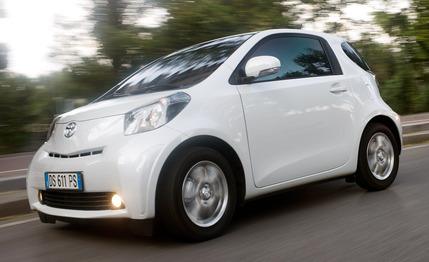
 First Drive Review
First Drive Review
Toyota didn’t get where it is today—the biggest, richest car company on the planet—by taking chances. With the notable exception of the Prius hybrid, Toyota styling is conservative to the point of boredom. And aside from its hybrid leadership, Japan’s automotive giant is rarely an innovator.
The trend toward downsizing, in both cars and engines, ought to be in Toyota’s favor. But although the company has plenty of economical babies in its global portfolio, it lacks a premium minicar. Mercedes’ Smart brand and BMW’s Mini have shown the world that small cars don’t have to be cheap.
Toyota wants a part of this expanding niche, and the iQ is its contender. It is significant that the concept emerged not from Japan but from Toyota’s European design center, located in France.
The new iQ brings both style and innovation. Its size dictated both: a length of 117.5 inches, a mere 11.4 inches longer than the Smart Fortwo, but unlike the Smart, the iQ seats four. The most admirable thing about the iQ is its packaging—the way in which the mechanical parts have been compressed to gain passenger space.
The iQ is a conventional transverse-engine, front-wheel-drive car, but the gearbox has been arranged so that the differential housing is located just in front of, rather than behind, the engine. The starter motor is incorporated into the compact flywheel, and the steering rack is mounted up high. A miniaturized air conditioner fits into a pod high up at the center of the dashboard, which allows the fire wall to be moved forward to increase cabin length. The dashboard is asymmetrical, and on the passenger side it is cut almost completely away so that the passenger sits farther forward than the driver, allowing more legroom for the rear-seat passenger. The fuel tank is shallow and housed under the floor, reducing the rear overhang.
Space in the front seats doesn’t seem small because the iQ is wider (66.1 inches) than the average minicar. There isn’t much room in the back; the space behind a tall driver is suitable only for a child’s seat. And with four aboard, there is really no place to put any luggage. The rear seats are very close to the liftgate, creating a potentially hazardous situation in a rear-end crash. Toyota has thought about that and provides a curtain airbag that deploys from behind the rear seats—in all, the iQ has nine airbags.
A drive showed that the iQ behaves much like other larger small cars and is without the nervousness of the Fortwo. The short wheelbase makes for a choppy ride, but otherwise the car feels refined and grown up.
The models to be sold in Japan and Europe include a 67-hp, 1.0-liter three-cylinder engine and a 1.4-liter diesel, both shared with the European and Japanese Yaris. Later, the iQ will get a new 1.3-liter gasoline four-cylinder, the engine that will power the U.S.-bound iQ. That 100-hp engine should allow the 1900-pound iQ to deliver fuel economy of about 40 mpg. Eventually, the 1.3-liter will find its way into other Toyota products, as will the iQ’s platform, which is expected to underpin the next Yaris.
The iQ will likely be priced near $20,000 when it goes on sale in Europe in January 2009. Its success depends less on its practicality, clever accommodation, and ease of parking and more on whether it will appeal to the fashionistas that have embraced Mini and the Smart. Will they continue to pay more for less?